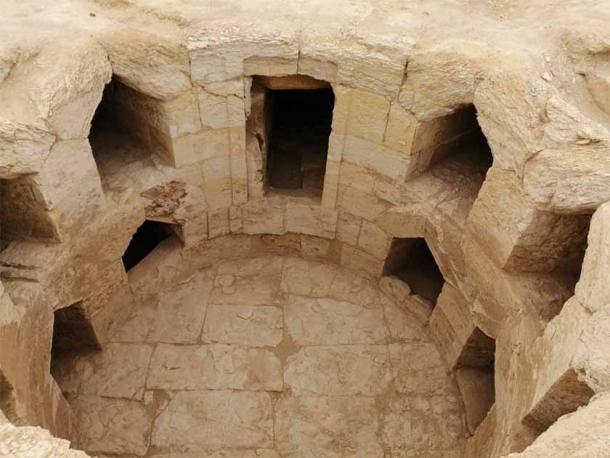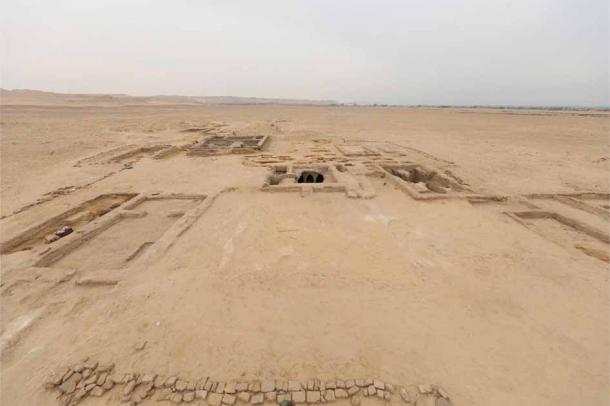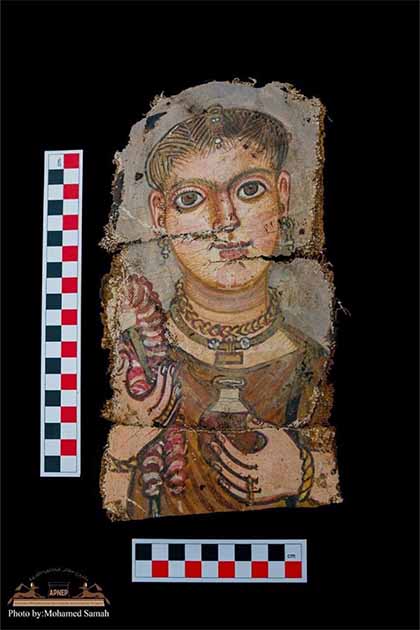
Huge Egyptian Tomb Discovered with Extraordinarily Rare Mummy Portraits
A huge funerary building has been excavated by researchers at the Gerza archaeological site in Fayum, Egypt. Rare artifacts were discovered, but a collection of mummy portraits represent the first such discovery for over 100 years.
Established in the 3rd century BC about 80 kilometers (50 miles) south of Cairo, Gerza was a central village in Fayum within the agricultural reclamation project implemented by King Ptolemy II (309 to 246 BC). Inhabited by both Egyptians and Greeks, Gerza was known to the latter as Philadelphia and its primary function was producing and exporting food supplies to the Egyptian kingdom.
- Mature Looking Mummy Portrait Was Actually Just A 4-Year-Old
- Fayum Mummy Portraits Expose Information About Precise Painting Techniques and Possible Neurological Disorders
Elite Gersha residents were buried in a huge tomb deep beneath the sandy streets of this agricultural outpost, and within it, archaeologists recovered the dusty faces of deceased ancient Egyptians in a collection of rare ancient mummy portraits.

One of the burial chambers at the newly uncovered site at Gerza. (Ministry of Tourism & Antiquities)
Coming Eye-to-Eye with Ancient Egyptian Mummy Portraits
Dr. Mostafa Waziri, Secretary General of the Supreme Council of Antiquities, said In a press release that the “huge” funerary structure was first identified in 2016. He said both the architecture and artifacts recovered within date back to the ancient Egyptian and Greek civilizations. To the south of the tomb’s colored lime mortar floor, which was finished with interchangeable tiles, a column shed was found containing four broken columns.
Heritage Daily reported that the funerary building was constructed of stone blocks and descended several floors into the ground. Towering arched stone doorways lead to six huge mud-brick tombs representing what the discoverers described as “mass graves in the Catacomb style.” Within the burial chambers archaeologists discovered “intricately decorated wooden coffins” carved in both ancient Egyptian and Greek letters.
However, the find that’s making the headlines was a group of well-preserved mummy portraits offering insights into the lives of the long-deceased ancient Egyptians.

The archaeological site in the Gerza cemetery where the rare mummy portraits were discovered. (Ministry of Tourism & Antiquities)
Mummy Portraits Guarded by the Goddess Isis-Aphrodite
Dr. Adel Okasha, head of the Central Department of Egyptian Antiquities in Central Egypt, said the mummy portraits were unearthed on the tenth excavation season of the archaeological mission. He explained that the new discoveries show the “diversity and difference in the accuracy and quality of the embalming process during the Ptolemaic and Roman eras.” What this means is that the corpses of deceased elites were given “high-quality embalming,” while lower-upper classes were left to rot.
Basem Gehad, the head of the mission, said the excavators recovered several different styled coffins, including some in human form and others in the Greek form with a gabled cover. Inside one of the wooden coffins the researchers found “a rare terracotta statue of the goddess Isis-Aphrodite,” the great fertility goddess associated with marriage, childbirth and rebirth. Furthermore, papyrus records written in Demotic and Greek script revealed the social, economic and religious conditions of the regional inhabitants, added Okasha.
Waiting 115 Years for Comparative Mummy Portraits
Okasha said the primary reason the mummy portraits are being heralded as “the most important discovery,” is because the last discovery of portraits in Fayum was made over 115 years ago by the English Egyptologist Sir William Matthew Flinders Petrie.
In the 1990s the British Museum hosted an exhibition titled Ancient faces: mummy portraits from Roman Egypt. This exhibit shared their understanding of mummy portrait painting technologies and materials. Now, these new portraits will allow for comparative analysis, revealing even more about how these arts were created.

One of the rare mummy portraits discovered in Egypt. (Ministry of Tourism & Antiquities)
Unearthing an Ancient Settlement Lost in the Sands of Time
According to a 2019 research paper published at Brigham Young University by Professor Kerry Muhlestein, the multinational settlement of Gerza (Philadelphia) is located where local hills provide access from the Nile Valley. It was ideally positioned for settling mercenaries, trade, distributing goods, to protect the Fayum and to collect taxes.
- Experts Discover Traces of Rare Artificial Pigment on Egyptian Mummy Portraits and Panel Paintings
- Tech Reveals A Little Girl Mummy Who Doesn’t Look Like Her Portrait
A military fortress was built to defend the site at the beginning of the 4th century, which indicates it was still flourishing at the time. Nevertheless, the settlement population declined rapidly soon after indicating the collapse of Gerza in the mid-4th century.
Gerza, Tanis, and all the other surrounding trading centers declined in the 4th and 5th centuries AD after the silting up and other damage to the Bahr Seila, which was “the agricultural lifeblood” for the communities of the northeast Fayum, according to Muhlestein. As the villages were abandoned the stories of the people were windswept and covered beneath the sand of time and lost for the last 2,300 years. This is why the mummy portraits are so important to archaeology: because they let us come face to face with ancient agriculturalists and traders living outside the mega-cities.
Top image: Composite image of the rare mummy portraits unearthed in Egypt. Source: Ministry of Tourism & Antiquities
By Ashley Cowie
















Comments
The Hyksos, however, were black-haired/Persian stock (via the Sumerians, the self-described black-headed people), arriving in Egypt around 1630 BC with a large contingent of female slaves who were used in the fabric-making, which was their trade. They quickly rose to power, but it was short-lived, and they were expelled about a hundred years later. Some think there may have been earlier contact between the fair-haired Egyptians and the Persians (also referred to as Semites, or a hybrid of two different species [Annunaki taking aboriginal wives] as per biblical texts), but the first major Persian migration into Egypt was the Hyksos. But like when the Romans were kicked out of Britain, many merchants in that contingent had become wealthy and remained behind with their riches, becoming ‘lords’ of sorts, marrying locals. In Egypt, it was probably the same. But safe to say that BEFORE the arrival of the Hyksos, the Egyptian population (who were the survivors of the Atlantis event and resulting Ice Age) were definitely fair-haired, as the mummies also tell us.
Nobody gets paid to tell the truth.
The study implying that the pharaohs were white was posted on ao a couple years ag.. js
infinitesimal waveparticles comprise what we call home the earth
manipulatable by thought ability supressed in humans since birth
Ill let pete decry the historical idiocy, i have a different point.. this just confirms the theory that the sons of marduk, were white..
Noone b4 commented on the fact that the portrait shows a caucasian??! Noone ges paid to rell the truth, but noones paid to be intelligent either
infinitesimal waveparticles comprise what we call home the earth
manipulatable by thought ability supressed in humans since birth
Im playing horizon zero dawn rn, and the guy that collects the mugs is a perfect example of this idiocy ..." Drinking out of such ornately constructed vessels? Thats stupid, its clearly a part of a shaving 'ritual'"
infinitesimal waveparticles comprise what we call home the earth
manipulatable by thought ability supressed in humans since birth
“Huge funerary structure” is a good example of how descriptions of something completely alter the underlying truth of them. It’s absolutely RIDICULOUS that any thinking person would see what they found there and associate it with an intentional method of ‘burying’ a dead body. There’s absolutely no way that ancient culture would create elaborately adorned subterranean chambers for the purpose of storing dead bodies. Funeral pyres were the civilized method of the day, NOT BURYING (torch is the root word in funeral). One would have to be the world’s biggest fool, or clinically insane, to believe it or not question their wild explanations. It is said that tens of millions of mummified bodies have been found or still lying in Egypt, all of the same basic era. The evidence CLEARLY suggests a horrendous calamity or genocide of those people in a single event. Most plausible is that they were an Atlantean culture (fair-haired) that perished suddenly, likely in the event that caused the sudden onset of the Ice Age (circa 115k BC), which perfectly fits Plato’s account of the destruction of Atlantis once you add the zero back to his timeline. Question becomes – is the industry intentionally twisting the truth about that or are they just NOT THINKING it through, as academia is unfortunately known for. So at this point, we see the explanations coming from the industry/institutions as a giant house of cards, leaning precariously, with the equivalent of bad (power-drunk?) structural engineers continuing to place more cards on top, ...with some really odd, misplaced cards on the bottom (e.g., the funerary non-sense) that nobody wants to focus on, knowing they hold up the mess above.
Nobody gets paid to tell the truth.